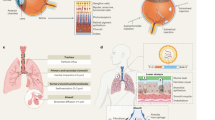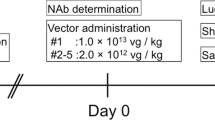Abstract
Hepatitis B virus envelope L particles form hollow nanoparticles displaying a peptide that is indispensable for liver-specific infection by hepatitis B virus in humans. Here we demonstrate the use of L particles for the efficient and specific transfer of a gene or drug into human hepatocytes both in culture and in a mouse xenograft model. In this model, intravenous injection of L particles carrying the gene for green fluorescent protein (GFP) or a fluorescent dye resulted in observable fluorescence only in human hepatocellular carcinomas but not in other human carcinomas or in mouse tissues. When the gene encoding human clotting factor IX was transferred into the xenograft model using L particles, factor IX was produced at levels relevant to the treatment of hemophilia B. The yeast-derived L particle is free of viral genomes, highly specific to human liver cells and able to accommodate drugs as well as genes. These advantages should facilitate targeted delivery of genes and drugs to the human liver.
This is a preview of subscription content, access via your institution
Access options
Subscribe to this journal
Receive 12 print issues and online access
$209.00 per year
only $17.42 per issue
Buy this article
- Purchase on Springer Link
- Instant access to full article PDF
Prices may be subject to local taxes which are calculated during checkout






Similar content being viewed by others
Accession codes
References
Verma, I.M. & Sonia, N. Gene therapy: promises, problems, and prospects. Nature 389, 239–242 (1997).
Friedmann, T. Human gene therapy: an immature genie, but certainly out of the bottle. Nat. Med. 2, 144–147 (1996).
VandenDriessche, T. et al. Lentiviral vectors containing the human immunodeficiency virus type-1 central polypurine tract can efficiently transduce nondividing hepatocytes and antigen-presenting cells in vivo. Blood 100, 813–822 (2002).
Chuah, M.K. et al. Therapeutic factor VIII levels and negligible toxicity in mouse and dog models of hemophilia A following gene therapy with high-capacity adenoviral vectors. Blood 101, 1734–1743 (2003).
Marshal, E. Viral vectors still pack surprises. Science 294, 1640 (2001).
Marshal, E. Gene therapy death prompts review of adenovirus vector. Science 286, 2244–2245 (1999).
Buckley, R.H. Gene therapy for SCID—a complication after remarkable progress. Lancet 360, 1185–1186 (2002).
Fox, J.L. Investigation of gene therapy begins. Nat. Biotechnol. 18, 143–144 (2000).
Heermann, K.H. et al. Large surface proteins of hepatitis B virus containing the pre-S sequence. J. Virol. 52, 396–402 (1984).
Kuroda, S., Itoh, Y., Miyazaki, T., Otaka-Imai, S. & Fujisawa, Y. Efficient expression of genetically engineered hepatitis B virus surface antigen P31 proteins in yeast. Gene 78, 297–308 (1989).
Fujisawa, Y., Kuroda, S., Van Eerd, P.M., Schellekens, H. & Kakinuma, A. Protective efficacy of a novel hepatitis B vaccine consisting of M (pre-S2+S) protein particles (a third generation vaccine). Vaccine 8, 192–198 (1990).
Kuroda, S., Fujisawa, Y., Iino, S., Akahane, Y. & Suzuki, H. Induction of protection level of anti-pre-S2 antibodies in humans immunized with a novel hepatitis B vaccine consisting of M (pre-S2+S) protein particles (a third generation vaccine). Vaccine 9, 163–169 (1991).
Kuroda, S., Otaka, S., Miyazaki, T., Nakao, M. & Fujisawa, Y. Hepatitis B virus envelope L protein particles, synthesis and assembly in Saccharomyces cerevisiae, purification and characterization. J. Biol. Chem. 267, 1953–1961 (1992).
Yamada, T. et al. Physicochemical and immunological characterization of hepatitis B virus envelope particles exclusively consisting of the entire L (pre-S1+pre-S2+S) protein. Vaccine 19, 3154–3163 (2001).
Marion, P.L., Salazar, F.H., Alexander, J.J. & Robinson, W.S. Polypeptides of hepatitis B virus surface antigen produced by a hepatoma cell line. J. Virol. 32, 796–802 (1979).
Neurath, A.R., Kent, S.B., Stick, N. & Parker, K. Identification and chemical synthesis of a host cell receptor binding site on hepatitis B virus. Cell 46, 429–436 (1986).
Le Seyec, J., Chouteau, P., Cannie, I., Guguen-Guillouzo, C. & Gripon, P. Infection process of the hepatitis B virus depends on the presence of a defined sequence in the pre-S1 domain. J. Virol. 73, 2052–2057 (1999).
Kobayashi, M. et al. Recombinant hepatitis B virus surface antigen carrying the pre-S2 region derived from yeast: purification and characterization. J. Biotechnol. 8, 1–22 (1988).
Chuah, M.K. et al. Gene therapy for hemophilia. J. Gene Med. 3, 3–20 (2001).
VandenDriessche, T., Collen, D. & Chuah, M.K.L. Viral vector-mediated gene therapy for hemophilia. Curr. Gene Ther. 1, 301–305 (2001).
Follenzi, A., Sabatino, G., Lombardo, A., Boccaccio, C. & Naldini, L. Efficient gene delivery and targeted expression to hepatocytes in vivo by improved lentiviral vectors. Hum. Gene Ther. 13, 243–260 (2002).
Itoh, Y., Kuroda, S., Miyazaki, T., Otaka, S. & Fujisawa, Y. Identification of polymerized-albumin receptor domain in the pre-S2 region of hepatitis B virus surface antigen M protein. J. Biotechnol. 23, 71–82 (1992).
Smith, K.R. Gene transfer in higher animals: theoretical considerations and key concepts. J. Biotechnol. 99, 1–22 (2002).
Ishikawa, H. et al. Utilization of variant-type of human α-fetoprotein promoter in gene therapy targeting for hepatocellular carcinoma. Gene Ther. 6, 465–470 (1999).
Carman, W.F. et al. Vaccine-induced escape mutant of hepatitis B virus. Lancet 336, 325–329 (1990).
Chiou, H.L., Lee, T.S., Kuo, J., Mau, Y.C., and Ho, M.S. Altered antigenicity of 'a' determinant variants of hepatitis B virus. J. Gen. Virol. 78, 2639–2645 (1997).
del Canho, R. et al. Ten-year neonatal hepatitis B vaccination program, The Netherlands, 1982–1992: protective efficacy and long-term immunogenicity. Vaccine 15, 1624–1630 (1997).
Michel, M.L. et al. Induction of anti-human immunodeficiency virus (HIV) neutralizing antibodies in rabbits immunized with recombinant HIV-hepatitis B surface antigen particles. Proc. Natl. Acad. Sci. USA 85, 7957–7961 (1988).
Arap, W. et al. Steps toward mapping the human vasculature by phage display. Nat. Med. 8, 121–127 (2002).
Yoshida, J., Mizuno, M. & Yagi, K. Efficient transfection of human interferon-β gene to human glioma cells by means of cationic multilamellar liposomes coupled with a monoclonal antibody. J. Neurooncol. 19, 269–274 (1994).
Sonveaux, N., Thines, D. & Ruysschaert, J.M. Characterization of the HBsAg particle lipid membrane. Res. Virol. 146, 43–51 (1995).
Murayama, Y. et al. Cell-specific expression of the diphtheria toxin A-chain coding sequence under the control of the upstream region of the human α-fetoprotein gene. J. Surg. Oncol. 70, 145–149 (1999).
Inoue, S., Ogawa, H., Yasuda, K., Umesono, K. & Tsuji, F.I. A bacterial cloning vector using a mutated Aequorea green fluorescent protein as an indicator. Gene 189, 159–162 (1997).
Acknowledgements
This study was supported by the Grants-in-Aid from the Japan Science and Technology Corporation (Research Fund for Patenting), the Ministry of Education, Culture, Sports, Science and Technology, Japan (nos. 13558110, 13218080, 15025240; the 21st century Center of Excellence program), TERUMO Life Science Foundation, Kowa Life Science Foundation, Naito Memorial Foundation (to S.K.), the Fund for Scientific Research (FWO, Belgium) and a Vlaams Interuniversitair Instituut voor Biotechnologie grant from the Flemish Government (to M.K.L.C. and T.V.).
Author information
Authors and Affiliations
Corresponding author
Ethics declarations
Competing interests
The authors declare no competing financial interests.
Rights and permissions
About this article
Cite this article
Yamada, T., Iwasaki, Y., Tada, H. et al. Nanoparticles for the delivery of genes and drugs to human hepatocytes. Nat Biotechnol 21, 885–890 (2003). https://doi.org/10.1038/nbt843
Received:
Accepted:
Published:
Issue Date:
DOI: https://doi.org/10.1038/nbt843
This article is cited by
-
Therapeutic applications of nanobiotechnology
Journal of Nanobiotechnology (2023)
-
Neutralization of hepatitis B virus with vaccine-escape mutations by hepatitis B vaccine with large-HBs antigen
Nature Communications (2022)
-
CD11c-specific bio-nanocapsule enhances vaccine immunogenicity by targeting immune cells
Journal of Nanobiotechnology (2018)
-
Advances in therapeutics for chronic hepatitis B
Hepatology International (2016)
-
A display of pH-sensitive fusogenic GALA peptide facilitates endosomal escape from a Bio-nanocapsule via an endocytic uptake pathway
Journal of Nanobiotechnology (2014)



